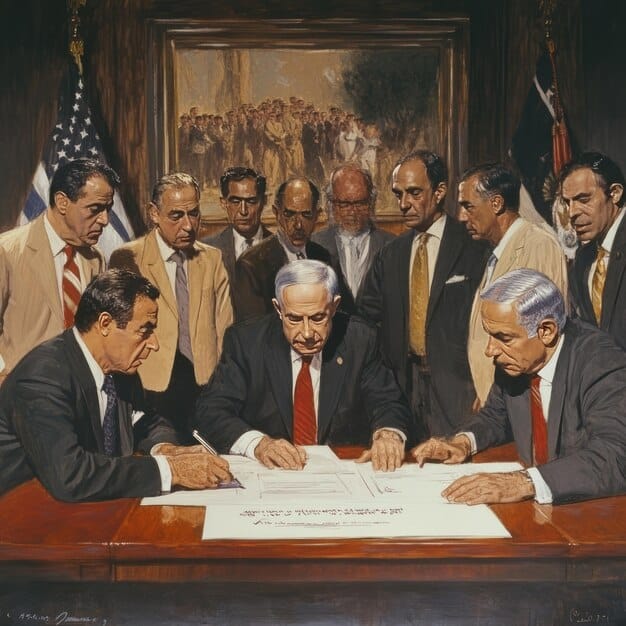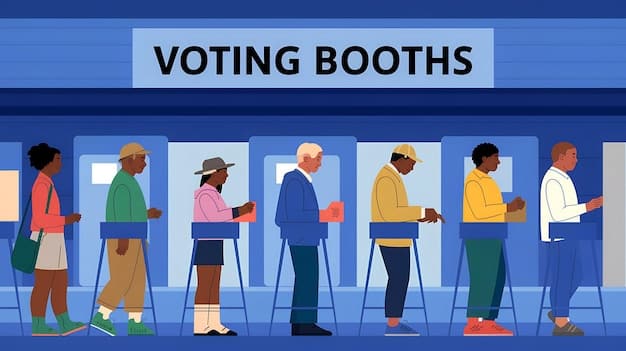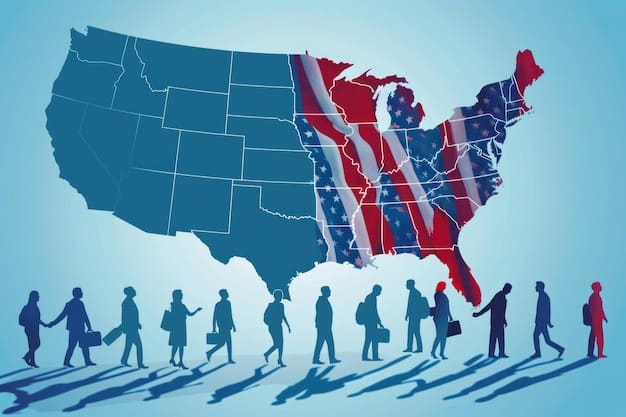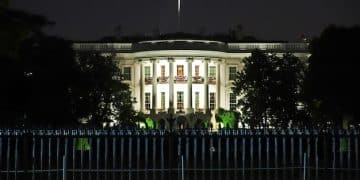1965 Voting Rights Act’s Enduring Impact on 2024 US Elections

The 1965 Voting Rights Act fundamentally reshaped American democracy by dismantling discriminatory voting practices, directly influencing the demographic and electoral landscape that continues to evolve and impact the 2024 US election cycle through expanded participation and ongoing legal battles over access.
The 1965 Voting Rights Act shape the 2024 US election landscape in ways that are both profound and perpetually evolving. This landmark legislation, enacted amidst the fervent struggle for civil rights, stands as a cornerstone of American democracy, fundamentally altering who can vote and how those votes are cast and counted.
The VRA’s Historical Context and Initial Impact
The journey to the 1965 Voting Rights Act (VRA) was paved with decades of systemic disenfranchisement, primarily targeting Black Americans in the Southern states. Before its passage, a labyrinth of discriminatory practices, including literacy tests, poll taxes, and intimidation tactics, effectively denied millions their fundamental right to vote.
The burgeoning Civil Rights Movement, fueled by leaders like Dr. Martin Luther King Jr. and countless unsung heroes, brought these injustices to the national forefront. Massive protests, such as the Selma to Montgomery marches, highlighted the desperate need for federal intervention to secure voting equality.
Era of Disenfranchisement
In the pre-VRA era, voting was often a perilous endeavor for Black Americans. State and local laws were meticulously crafted to suppress their political power. The sheer scale and ingenuity of these methods were staggering, creating a caste system where political participation was largely determined by race.
- Literacy Tests: Often administered unfairly, these tests demanded a level of understanding that even many educated white Americans would struggle with, designed to fail Black applicants regardless of their literacy.
- Poll Taxes: An economic barrier that disproportionately affected low-income Black communities, effectively pricing them out of the ballot box.
- Grandfather Clauses: Exempted individuals whose ancestors could vote prior to 1866 or 1867, effectively preserving white supremacy in voter rolls.
- Intimidation and Violence: Beyond legal tactics, physical threats, economic retaliation, and even violence were used to deter Black citizens from attempting to register or vote.
The cumulative effect of these practices was a significant racial disparity in voter registration and turnout, undermining the very principles of democracy. The courage of those who risked everything to register and demand their rights provided the moral imperative for legislative change.
By bringing these systemic abuses to light, the Civil Rights Movement not only sparked a national conscience but also laid the groundwork for President Lyndon B. Johnson to champion comprehensive voting rights legislation. The Act itself was a direct response to the glaring inequities that had permeated the American political system for too long.
Key Provisions and Immediate Legislative Triumph
The 1965 Voting Rights Act was not merely symbolic; it was a powerful piece of legislation with concrete mechanisms designed to dismantle discriminatory voting practices. Its core was a simple yet revolutionary concept: ensuring the right to vote for all citizens, regardless of race or color.
At its heart, the VRA outlawed discriminatory voting practices adopted in many Southern states. It banned literacy tests and other subjective voter qualification devices that had been used to disenfranchise Black Americans. Perhaps its most significant, and controversial, provision was Section 5.
Section 5: Preclearance and Federal Oversight
Section 5 mandated “preclearance,” requiring certain states and local governments with a history of voter discrimination to obtain federal approval from the U.S. Department of Justice or the U.S. District Court for the District of Columbia before implementing any changes to their voting laws. This provision was a recognition that simply outlawing discrimination was not enough; preventative measures were needed given the entrenched nature of the problem.
- Preventative Measure: Acted as a powerful deterrent against new discriminatory laws, as states knew their proposed changes would face federal scrutiny.
- Dynamic Enforcement: Allowed the federal government to adapt to evolving attempts at voter suppression, preventing new tactics from taking root.
- Jurisdictional Targeting: Applied specifically to jurisdictions with a demonstrable history of racial discrimination in voting, ensuring the enforcement was targeted where most needed.
The immediate impact of the VRA was undeniable. Within years, voter registration among Black Americans in the South soared, and the number of Black elected officials increased dramatically. This fundamental shift introduced millions of new voters into the electorate, transforming the political landscape in states that had long been dominated by a white minority.
The Act’s rigorous enforcement during its initial decades solidified its reputation as one of the most effective pieces of civil rights legislation in American history. It demonstrated the federal government’s commitment to protecting fundamental rights and paved the way for a more inclusive democracy.
The Evolution of Voting Rights: Challenges and Amendments
While the Voting Rights Act was a monumental achievement, its history is also one of continuous challenge and adaptation. The battle for voting rights did not end in 1965; rather, it shifted from overt, legally enshrined discrimination to more subtle, yet still potent, forms of suppression.
Over the decades, the VRA has been reauthorized by Congress multiple times, reflecting a bipartisan commitment to its goals, even as political landscapes changed. Each reauthorization often included new provisions to address emerging challenges to voting access, such as protections for language minorities.

Key Amendments and Judicial Scrutiny
Several amendments expanded the VRA’s scope beyond its original intent, reflecting a broader understanding of voting rights. For example, the 1975 amendments expanded the Act’s protections to language minorities, requiring voting materials to be available in multiple languages in certain jurisdictions. This was a crucial step towards ensuring that language barriers did not become a new form of disenfranchisement.
- Language Minority Protections (1975): Required bilingual voting materials and assistance in areas with significant language minority populations.
- Permanent Ban on Literacy Tests (1975): Made the nationwide ban permanent, eliminating any lingering doubts about their legality.
- Expanded Federal Oversight: Continuously refined the criteria for federal oversight and intervention, adapting to changing demographics and tactics.
However, the VRA also faced significant judicial scrutiny, most notably in the landmark 2013 Supreme Court case, Shelby County v. Holder. This decision effectively gutted Section 5, ruling the formula used to determine which jurisdictions were subject to preclearance was outdated and unconstitutional. The Court argued that the system was no longer necessary given the progress made in racial equality.
The Shelby County decision had immediate and far-reaching consequences. Without the preclearance requirement, formerly covered jurisdictions were free to change their voting laws without federal approval. Many critics argue that this opened the door to a new wave of restrictive voting measures, from stricter voter ID laws to polling place closures, disproportionately impacting minority voters once again. The ongoing debate about Section 5’s future remains a central point of contention in voting rights activism and legislative efforts.
The Post-Shelby Landscape and Voter Access Debates
The 2013 Supreme Court decision in Shelby County v. Holder marked a pivotal moment in the history of the VRA, dramatically altering the landscape of voting rights. By invalidating the preclearance formula, the ruling removed a crucial safeguard against discriminatory voting practices in jurisdictions with a history of voter suppression.
The immediate aftermath of Shelby County saw a surge in the introduction of new voting laws across the country, particularly in states previously covered by Section 5. These laws often included stricter voter ID requirements, limitations on early voting, purges of voter registration rolls, and the closure of polling places, especially in minority-majority districts.
New Forms of Voter Suppression
The nature of voter suppression has evolved significantly since the VRA’s passage. While overt tactics like literacy tests are largely gone, new methods have emerged that, while often framed as efforts to ensure “election integrity,” can disproportionately impact certain demographic groups.
- Strict Voter ID Laws: Requiring specific forms of photo identification that many elderly, low-income, or minority citizens may not possess or find difficult to obtain.
- Voter Roll Purges: Aggressive removal of voters from registration lists, sometimes leading to eligible voters being mistakenly disenfranchised.
- Polling Place Closures: Reducing the number of polling locations, leading to longer lines and increased travel distances, particularly in urban and rural minority communities.
- Gerrymandering: Manipulating electoral district boundaries to favor one party or reduce the voting power of specific demographic groups.
These practices have fueled intense legal and political battles, with civil rights organizations and voting rights advocates continuously challenging them in courts. The debates surrounding these issues are often highly polarized, reflecting deeper divisions over the balance between electoral security and voter access.
The push for federal legislation to restore and strengthen voting rights protections, such as the John Lewis Voting Rights Advancement Act, reflects the ongoing urgency perceived by many to counteract the effects of the Shelby County decision. The absence of federal preclearance means that much of the burden of fighting discriminatory practices now falls on state-level litigation, which can be costly, time-consuming, and inconsistent in its outcomes.
Demographic Shifts and Electoral Realignment
Beyond immediate legal battles, the 1965 Voting Rights Act also catalyzed long-term demographic and electoral realignments that fundamentally shape contemporary American politics. By enfranchising millions of Black Americans, and later other minority groups, the VRA significantly altered the composition of the electorate, particularly in the South.
This expansion of the electorate had profound ripple effects. It empowered new voting blocs, leading to shifts in political power and representation. The South, once a solidly Democratic region due to the legacy of white conservative voters, began its slow but steady transition towards becoming predominantly Republican, as the Democratic Party increasingly embraced civil rights.
The VRA’s influence extends to the election of minority officials at all levels of government, from local school boards to Congress. This increased representation not only brought diverse voices into policy-making but also served as an inspiration for civic engagement within minority communities.
Impact on Political Parties and Coalitions
The expanded electorate forced both major political parties to reconsider their strategies and platforms. The Democratic Party, by actively supporting and benefiting from minority voter turnout, solidified its identity as the party championing civil rights and social justice. This shift, however, alienated many white Southern voters, who then largely migrated to the Republican Party.
- Democratic Party’s Evolving Coalition: Strengthened its base among African Americans, urban voters, and increasingly, other minority groups.
- Republican Party’s Southern Strategy: Capitalized on the discontent of white Southern Democrats, leading to a significant Republican ascent in former Democratic strongholds.
- Increased Minority Representation: The VRA facilitated the election of a historically unprecedented number of minority officials, influencing state and national policy agendas.
The long-term effects of these realignments are clearly visible in the 2024 election cycle. Minority voters, particularly Black Americans, remain a crucial constituency for the Democratic Party, often serving as a firewall in key states. Conversely, the Republican Party’s strategy often involves appealing to a predominantly white conservative base, while also making efforts to attract minority voters, though with varying degrees of success.
Understanding these historical shifts is critical to interpreting modern electoral dynamics. The VRA didn’t just grant a right; it reshaped the very foundations of American political parties, alliances, and regional voting patterns, creating the diverse and complex electorate we see today.
The 2024 Election: VRA’s Legacy in Action
The 2024 US election landscape is undeniably shaped by the enduring legacy of the 1965 Voting Rights Act, even despite the changes brought by the Shelby County decision. Its principles continue to animate debates over voter access, election integrity, and the very health of American democracy.
In 2024, the VRA’s influence manifests in several critical ways. First, the ongoing legal battles over state-level voting restrictions highlight the Act’s remaining provisions, particularly Section 2, which prohibits voting practices that discriminate on the basis of race, color, or language minority status. Lawsuits challenging gerrymandering and restrictive voter ID laws are often predicated on Section 2, demonstrating its continued relevance as a tool for protecting voting rights.

Voting Rights and Electoral Strategies in 2024
Both major political parties are navigating an electorate profoundly changed by the VRA. Democratic strategies heavily rely on robust voter turnout among minority groups and young voters, often advocating for policies that expand early voting, same-day registration, and automatic voter registration. Their narratives often emphasize historical disenfranchisement and the importance of protecting voting rights.
- Voter Education and Registration: Campaigns and non-profits are actively engaged in informing eligible voters about their rights and assisting with registration, especially in underserved communities.
- Litigation as a Tool: Voting rights organizations constantly monitor new state laws and initiate lawsuits under Section 2 of the VRA to challenge potentially discriminatory practices.
- Focus on Electoral Integrity: While often framed differently, both parties claim to prioritize election integrity. For Democrats, this often means ensuring broad access; for Republicans, it frequently means securing elections against perceived fraud.
Republican strategies in 2024 often focus on what they term “election security,” which can include advocating for stricter voter ID laws, limits on mail-in voting, and more aggressive voter roll maintenance. While proponents argue these measures prevent fraud, critics contend they disproportionately burden minority and low-income voters, harkening back to the debates that first led to the VRA.
Furthermore, the demographics of the 2024 electorate are far more diverse than in 1965, a direct consequence of the VRA’s success. The growing political power of Hispanic, Asian American, and other minority groups, alongside the continued significance of the Black vote, means that candidates must appeal to a mosaic of communities, each with distinct needs and historical experiences. The very composition of “swing states” and competitive districts is a testament to the VRA’s long-term impact on electoral geography.
The Future of Voting Rights in America
The 1965 Voting Rights Act, while revolutionary, faces an uncertain future. The balance between protecting voting rights and ensuring election security remains a fiercely debated topic, influencing legislative efforts, judicial interpretations, and grassroots activism across the nation.
A central question in the post-Shelby County era is how to address new and evolving attempts at voter suppression without the preventative power of Section 5. Congress has repeatedly attempted to pass new federal voting rights legislation, such as the For the People Act and the John Lewis Voting Rights Advancement Act, which aim to restore parts of the VRA’s potency and establish national standards for voting access.
Ongoing Legislative and Judicial Battles
The push for federal intervention faces significant political hurdles, frequently stalling in Congress due to partisan divisions. This legislative inertia means that many voting rights battles are now fought at the state level, in state legislatures and courts, resulting in a patchwork of laws that vary significantly from one jurisdiction to another.
- Federal Legislative Impasse: Efforts to pass comprehensive federal voting rights legislation remain largely stymied, leaving state laws to dictate much of voter access.
- State-Level Litigation: Civil rights groups are increasingly relying on Section 2 of the VRA and state constitutions to challenge restrictive voting laws in court.
- Technological Evolution: The rise of issues like online voter registration, cybersecurity of election systems, and the spread of election misinformation present new challenges not envisioned in 1965.
The judiciary also continues to play a critical role. Future Supreme Court decisions on Section 2 cases, or potential challenges to state voting laws, could further redefine the scope of voting rights in America. The interpretation of what constitutes “discriminatory effect” under the VRA is a particularly live issue. Furthermore, the role of federal agencies like the Department of Justice in monitoring and prosecuting voting rights violations remains crucial.
Beyond legislation and courtrooms, the future of voting rights will also be shaped by ongoing citizen engagement, advocacy, and education. Grassroots movements continue to organize voter registration drives, combat disinformation, and push for fairer electoral maps. The fight for the fundamental right to vote, sparked by the VRA, remains a defining feature of the American democratic experiment, constantly adapting to new challenges and reaffirming its enduring importance.
| Key Point | Brief Description |
|---|---|
| 📜 VRA’s Foundation | Enacted in 1965 to dismantle discriminatory voting practices, especially in the South. |
| ⚖️ Shelby County Impact | 2013 Supreme Court decision ended preclearance, leading to new waves of voting restrictions. |
| 🗳️ 2024 Election Echoes | Debates over voter access and election integrity directly reflect the VRA’s ongoing legacy. |
| 📈 Demographic Shifts | VRA fundamentally reshaped the electorate, empowering diverse voting blocs. |
Frequently Asked Questions about the Voting Rights Act and the 2024 Election
The primary goal of the 1965 Voting Rights Act was to overcome legal barriers at state and local levels that prevented African Americans from exercising their right to vote under the 15th Amendment. It outlawed discriminatory voting practices like literacy tests and poll taxes, dramatically increasing voter registration among minority populations.
The 2013 Supreme Court decision in Shelby County v. Holder invalidated Section 4(b) of the VRA, which contained the formula for identifying jurisdictions subject to federal preclearance under Section 5. This effectively rendered Section 5 unenforceable, allowing many states to change voting laws without federal oversight, leading to new voter restriction debates.
Even after Shelby County, Section 2 of the VRA remains intact. It prohibits any voting qualification or practice that results in a denial or abridgment of the right to vote on account of race or color. In 2024, Section 2 is frequently used in lawsuits challenging discriminatory redistricting, voter ID laws, and other state-level voting restrictions.
By removing barriers to voting for minority groups, the VRA significantly expanded the electorate. This led to increased voter turnout and representation for African Americans and other minorities, fundamentally reshaping the demographic makeup of voters and influencing party strategies and electoral outcomes across the country, especially in the Southern states.
Yes, there are ongoing legislative efforts in Congress to pass bills like the John Lewis Voting Rights Advancement Act. These bills aim to restore and modernize the VRA’s provisions, particularly addressing the impact of the Shelby County decision and establishing clearer criteria for federal oversight of voting rule changes. However, these efforts often face significant political challenges.
Conclusion: An Enduring Framework for Democracy
The 1965 Voting Rights Act fundamentally redefined American democracy, transforming an often-exclusive system into one striving for broader inclusion. While its original provisions have faced challenges and its future remains subject to ongoing debate and judicial review, its profound impact on the 2024 US election landscape is undeniable. From the demographic shifts it catalyzed to the ongoing nationwide legal battles over voter access, the VRA serves as a foundational framework, reminding us that the right to vote, though often taken for granted, requires constant vigilance and protection. It underscores the continuous journey towards a more perfect union, where every eligible citizen’s voice can be heard.





